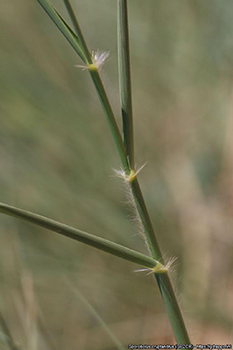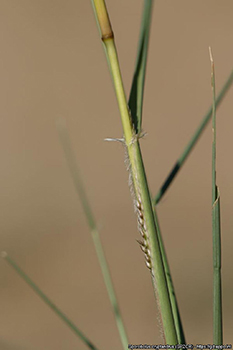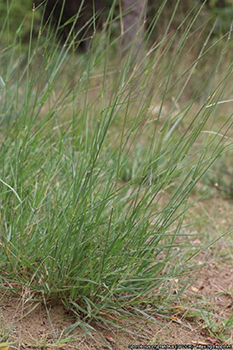
EPPO Alert List – Sporobolus cryptandrus (Poaceae)
Why
Sporobolus cryptandrus (Poaceae) is known from isolated populations in the EPPO region. Several locations are recently reported from Hungary where it can form monospecific stands. Further information is sought on the spread and impacts of S. cryptandrus in the EPPO region.


Sporobolus cryptandrus in Hungary
Courtesy: Eszter Aradi

Geographical distribution
EPPO region: Austria, France, Germany, Hungary, Italy, Netherlands, Russia, Slovenia, Spain, Switzerland, Ukraine, United Kingdom.
North America: Canada (native), United States of America (native), Mexico (native).
Oceania: Australia (New South Wales and Tasmania).
South America: Argentina.
Morphology
Plants perennial not rhizomatous.
Mature plants range from 27 to 100 cm tall. Plants are typically erect but may also be decumbent. The collar has a conspicuous tuft of white hairs which may be up to 0.4 cm long. Leaf blades are 0.2 to 0.6 cm wide and 7 to 25 cm long. The inflorescence is a panicle, 15 to 40 cm long and 2.4 to 13 cm wide, initially contracted and spike-like, but opening with maturity into a pyramidal shape as the inflorescence escapes the subtending sheath. Spikelets contain a small, single brown to purplish floret.
Biology and Ecology
Sporobolus cryptandrus is an invasive perennial C4 grass species which is drought tolerant. The species mainly spreads through seed.
Habitats
Sporobolus cryptandrus often grows on dry sandy soils. In Hungary, S. cryptandrus is recorded in a number of different habitats including urban areas (car parks, road verges, and tramlines), disturbed or degraded areas of open sand grassland, ploughed fire buffer zones, old field sites of various ages and species composition, grassland used for livestock feeding and, the species was recorded encroaching into natural open sandy grassland.
Pathways for movement
Wind dispersed seed can ensure natural spread of the species. There is no clear evidence for pathways for movement over long distances. However, propagules may be spread via contaminated growing substrate (sand or soil) and as a contaminant of used machinery and equipment.
Impacts
Sporobolus cryptandrus can have a negative impact on the species richness and abundance of native vegetation. S. cryptandrus can produce an abundance of small seeds (up to 10 000 seeds per panicle) which can form a persistent seed bank (over 3 000 seeds per m²). This facilitates establishment of the species in new areas and complicates the control of the species as the seed bank will need to be exhausted to achieve successful control.
Control
There is no specific information on control. Any management method should exhaust the persistent seedbank.
Sources
Kröel-Dulay G, Rigó A, Tanács E, Szitár K, Ónodi G, Aradi E, Bakró-Nagy Z, Biró M, Botta-Dukát Z, Kalapos T, Kelemen A, Laborczi A, Pásztor L, Rabuogi QA, Mojzes A (2024) Explosive spread of sand dropseed (Sporobolus cryptandrus), a C4 perennial bunchgrass, threatens unique grasslands in Hungary (Central Europe). NeoBiota 95, 59-75.
Tilley D, St. John L, Ogle D (2009) Plant guide for sand dropseed (Sporobolus cryptandrus). USDA Natural Resources Conservation Service, Idaho Plant Materials Center. Aberdeen, ID
Török P, Schmidt D, Bátori Z, Aradi E, Kelemen A, Hábenczyus AA, Diaz CP, Tölgyesi C, Pál RW, Balogh N, Tóth E, Matus G, Táborská J, Sramkó G, Laczkó L, Jordán S, Sonkoly J (2021) Sand dropseed (Sporobolus cryptandrus) – a new pest in Eurasian sand areas? BioRxiv. https://doi.org/10.1101/2021.07.05.451115
